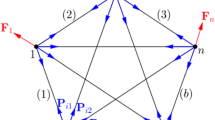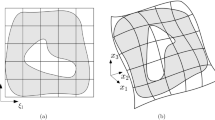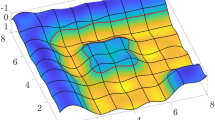Abstract
This paper presents theory and implementation of a method for detecting interference between a pair of solid objects. Often at times, when performing simulations, two solids may unwittingly interpenetrate each other. The two components of the system presented in this paper are: (1) a surface representation method to model solid objects; and (2) a method for detecting interference. Body representation of a solid in this system is based upon enveloping each solid with surfaces (called positive entities). Most computer aided design (CAD) systems use solid modeling techniques to represent solid objects. Since most solid models use Boolean operations to model complex objects, a method is presented to envelop complex objects with parametric surfaces. A method for tracing intersection curves between two surfaces is also presented. Discontinuities on surfaces are defined as negative entitics in order to extend the method to complex solids. Determining interference is based upon a numerical algorithm for computing points of intersection between boundary curves and parametrized entities. The existence of segments of these curves inside the boundary of positive and negative entities is established by computing the circulation of a function around the boundary curve. Interference between two solids is then detected. No limitations are imposed on the convexity or simplicity of the boundary curves treated.
Similar content being viewed by others
References
Pratt, M.J.; Geisow, A.D. (1986) Surface/surface intersection problems, The Mathematics of Surfaces, Vol. 6 (Gregory, J.A., Editor), Clarendon Press, Oxford, 117–142
Boyse, J.W. (1979) Interference detection among solids and surfaces, Communications of ACM, 22 (1), January, 3–9.
Pasarello, C.E. (1982) Interference detection using barycentric coordinates, Mechanics Research Communications (UK), 9, 6, 373–378
Uchiki, T.; Ohashi, T.; Tokoro, M. (1983) Collision detection in motion simulations, Computer and Graphics 7, 3–4, 285–293
Udupa, S.M. (1977) Collision detection and avoidance in computer controlled manipulators. Proceedings of the 5th JJCAI-Robotics, 737–748
Wong, S.; Fu, K.S. (1985) A hierarchical orthogonal space approach to collision free path planning, IEEE, 7, 506–511
Cameron, S. (1989) Efficient intersection tests for objects defined constructively, Int. J. Robot. Res., 8, 1, 3–25
Seitz, B.; Cipra, R.J. (1992) Real-time collision avoidance of a planar manipulator with an interfering single link arm, Proceedings of the IEEE International Conference on Robotics and Automation, Vol. 2, 1494–1499
Mitsi, S.; Bouzakis, K. (1993) Simulation of redundant manipulators for collision avoidance in manufacturing and assembly environments, Mechanism and Machine Theory, 28 (1), 13–21
Wang, D.; Hamam, Y. (1992) Optimal trajectory planning of manipulators with collision detection and avoidance, Int. J. Robotics Research, 11, 5, 460–468
Meyer, W. (1986) Distances between boxes: applications to collision detection and clipping, IEEE International Conference on Robotics and Automation, 597–602
Gilbert, E.G. (1989), Computing the distance between smooth objects in three-dimensional space, Proceedings of IEEE International Conference on Robotics and Automation, Scottsdale AZ, (1989), 1, 158–163
Zghal, H. et al. (1992) Collision avoidance of a multiple degree of redundancy manipulator operating through a window, J. Dynamic Systems, 114, 4, 717–721
Tilove, R.B. (1980) Set membership classification: a unified approach to geometric intersection problems, IEEE Trans. Computers, 29, 10, 874–883
Akin, J.E. (1990) Computer Assisted Mechanical Design, Prentice Hall, Englewood Cliffs, NJ
Requicha, A.A. (1980) Representations for rigid solids: theory, methods, and systems, Computing Surveys, 12, 14, 437
Requicha, A.A. (1983) Solid modeling: current status and research directions, IEEE Computer Graphics and Applications, 3, 7, Oct. 1983, 25–30 and 32–37
Qiulin, D.; Davies, B.J. (1987) Surface Engineering Geometry for Computer-Aided Design and Manufacturing, Ellis Horwood, Chichester
Abdel-Malek, K. (1995) A numerical algorithm for detecting interference among complex links of manipulator arms, Int. J. Robotics Automation (in press)
Haug, E.J.; Luh, C.M.; Adkins, F.; Wang, J.Y. (1994) Numerical algorithms for mapping boundaries of manipulator workspaces, Proceedings of the 24th ASME Mechanisms Conference
Allgower, E.L.; Georg, K. (1990) Numericcal Continuation Methods, Springer-Verlag, Berlin, Heidelberg
Noble, B.; Daniel, J.W. (1998) Applied Linear Algebra, Prentice-Hall, Englewood Cliffs, NJ
Keller, H.B. (1987) Lectures on Numerical Methods in Bifurcation Problems, Springer Verlag, Berlin, Heidelberg, New York
Golubitsky, M.; Stewart, L.; Schaeffer, D.G. (1988) Singularities and Groups in Bifurcation Theory, Vol. II, Springer Verlag, Berlin, Heidelberg, New York
Lucaks, G. (1990) Simple singularities in surface-surface intersections. The Mathematics of Surfaces (Gregory, J.A., Editor), Clarendon Press, Oxford
Author information
Authors and Affiliations
Rights and permissions
About this article
Cite this article
Abdel-Malek, K.A., Yeh, H.J. & Maropis, N. Determining interference between pairs of solids defined constructively in computer animation. Engineering with Computers 14, 48–58 (1998). https://doi.org/10.1007/BF01198974
Issue Date:
DOI: https://doi.org/10.1007/BF01198974




